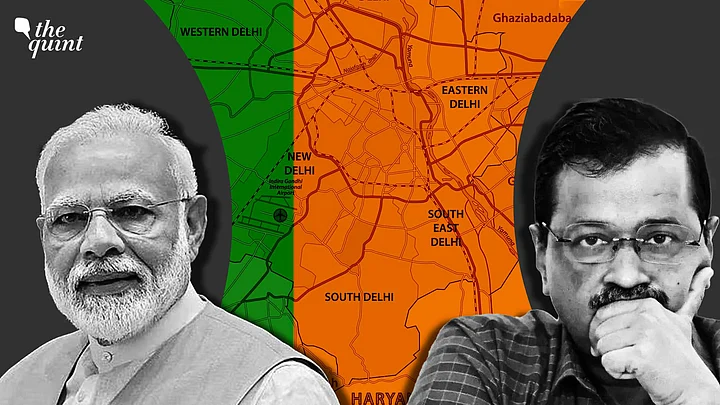At a soiree hosted by a Janata Dal (United) leader at the national capital, a top-ranking Bharatiya Janata Party (BJP) functionary and Union minister said that the saffron party has a 50 percent chance of winning the Delhi Assembly elections. Known to be the BJP's key election strategist, he added the party is pulling out all the stops to win 50 percent votes in Delhi.
The BJP's vote share in Delhi over the past few Assembly elections forms a pattern resembling a crescent. From over 47 percent vote share in the 1993 Assembly elections, the party’s polled votes dipped to 34 percent in 1998. Subsequently, the BJP’s vote share remained stuck in a narrow range, only to climb marginally to above 38 percent in the 2020 Assembly elections.
Knowing well that the BJP can wrest power in Delhi by bagging over 45 percent votes, the saffron outfit seems to have mustered all its election strategists from across the country to the capital.
Team Amit Shah Leads BJP’s Delhi Poll Plan
The Delhi unit of the BJP had mostly been unfamiliar with Nizamabad MP Arvind Dharmapuri from Telangana. Now, Dharmapuri, known to have the ears of Amit Shah, is marshalling the BJP’s strategy in the RK Puram Assembly constituency. The South Delhi area of RK Puram has a sizable population of the people from the southern parts of the country. Dharmapuri has the task to swing the votes in the BJP’s favour.
Meanwhile, Shah’s political sherpas, consisting of his close aides such as Union ministers Dharmendra Pradhan, Bhupender Yadav, Piyush Goyal, Mansukh Mandaviya, and Anurag Thakur, are helming the party’s charge in two seats each as part of the ‘Rajanitik Prabandhan' (political management) taskforce.
Amit Shah’s key aides from other states such as former Madhya Pradesh minister Narottam Mishra, the BJP’s general secretaries Vinod Tawde, Tarun Chugh, Sunil Bansal, and many others are also part of the political management group.
All Hands on Deck for BJP in Delhi
A senior BJP functionary, while speaking about the unprecedented scale of the electioneering this year, said the impact can be seen in war rooms, which have now become decentralised, with several of them dealing with specific tasks.
One war room is specially tasked to feed hundreds of groups of social influencers who have been entrusted to target groups at political booth levels. Another war room is feeding inputs for small indoor meetings.
Almost a year ago, the BJP had armed itself with a dashboard that can zero in on voting trends, right down to the level of even a small lane in a Delhi mohalla.
Pointing at an Assembly constituency graph in the dashboard, a dismayed senior BJP leader said there are four wards in that region with a large number of people from Gujarat, but they don’t vote for the BJP here in the Assembly elections.
The party has thus brought in social and political influencers to work for such demographic groups who hail from states where the BJP is in power but vote for the Aam Aadmi Party (AAP) in Delhi.
The BJP's General Secretary (Organisation) BL Santhosh is the party's key election coordinator. Delhi, however, is a different territory.
So, all the top guns of the BJP are in the poll battlefield with the sole mandate to influence the people with the narrative that “Arvind Kejriwal is an anarchist, and he is solely responsible for the ills” of the national capital.
BJP's Delhi Poll Blitzkrieg Harks Back to 2015 Bihar Elections
High on the arrival of Prime Minister Narendra Modi as the poll mascot, the BJP sought revenge on Nitish Kumar in the 2015 Assembly elections in Bihar. It wanted to level scores against the Bihar chief minister for cancelling a dinner for the party leaders in 2013.
The party brought a full army of leaders from northern and western states – and they all occupied hotels in Patna.
A leading hotel in Patna almost turned into a BJP fort. At the time, Kumar, however, proved to be a step ahead of the BJP and ran away with the state poll verdict by raising the plank of Bihari pride under assault from outsiders.
'Targeting Kejriwal' Central to BJP Electioneering
Former BJP vice president Vinay Sahasrabuddhe turned into a podcaster during the Maharashtra Assembly elections in November. In Delhi, he is back as a podcaster with the first podcast with Lieutenant Governor Vinai Kumar Saxena, and his latest conversation with Union Minister Hardeep Singh Puri.
The Sahasrabuddhe podcasts amplify hosts accusing Kejriwal of being an 'anarchist' who doesn’t let any step be taken. The Sahasrabuddhe podcasts, along with many more, are part of the BJP’s efforts to dent Kejriwal’s middle class image with electioneering blitzkrieg.
In addition, the Maharashtra model of election management has been deployed for the Delhi elections. The Rashtriya Swayamsevak Sangh (RSS) and its various affiliates are holding closed-door meetings at levels of political booths.
It has also been learnt that the RSS functionaries, who are otherwise on long-term deputations in other regions, are pitching their tents in the national capital. ‘Anything extra will help’ appears to be the mantra of the BJP in Delhi.
The Maharashtra poll win partially restored the bruised 'Brand Modi' that had taken a major hit in the Lok Sabha elections. For the BJP, a win in Delhi will be an assertion of 'Brand Modi'.
(Manish Anand is a Delhi-based senior journalist, with over two decades of political reporting career with The New Indian Express, Deccan Chronicle, The Asian Age, and The Statesman. This is an opinion piece. All views expressed are the author’s own. The Quint neither endorses nor is responsible for them)
